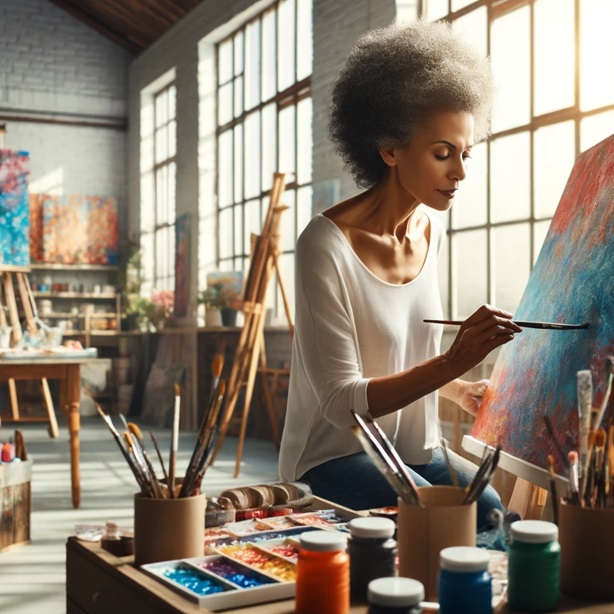The Power of Creativity in Cognitive Development
When we think about creativity, we often associate it with artistic pursuits and aesthetic sensibilities. However, creativity is also a cognitive process that enhances mental capacity and flexibility. The act of creating—whether it be through drawing, painting, or writing—is fundamentally an act of problem-solving. Each brush stroke, each word written, each line drawn represents a series of decisions made by the brain, each one an opportunity to explore new neural pathways.
This complex cognitive activity strengthens the brain's executive functions, which are responsible for managing tasks like planning, attention to detail, and multitasking. Moreover, the iterative nature of creative work—constantly refining and revising one's output—mirrors the cognitive process of developing and enhancing ideas, a skill highly valuable in both personal and professional contexts.
Research indicates that creative activities can have a profound impact on the brain's neuroplasticity—the ability of the brain to reorganize itself by forming new neural connections throughout life. This plasticity is crucial for cognitive growth, and engaging in creative tasks is a practical way to nurture and develop it.
Enhancing Cognitive Flexibility through Artistic Endeavors
The fluid nature of artistic endeavors requires the brain to remain flexible, adapting to new visualizations and concepts. As one engages in drawing or painting, they are often faced with challenges such as perspective, composition, and color theory. Addressing these challenges engages several brain regions, including the frontal cortex, which is responsible for complex cognitive tasks such as planning and problem-solving.
Furthermore, the sensory experience of interacting with various materials like paint, clay, or graphite provides sensory feedback that stimulates the brain's sensory cortex. This stimulation enriches the brain's understanding of textures and spatial relationships, further contributing to cognitive agility.
Art also invokes an emotional response, engaging the limbic system—the brain's emotional center. This connection between the cognitive aspects of art-making and emotional processing demonstrates the comprehensive impact artistic activities can have on brain development, influencing not only cognitive skills but also emotional intelligence.
The Multifaceted Cognitive Benefits of Writing
Writing is a conduit for expression and communication, but its benefits for cognitive development are multifaceted. Constructing coherent narratives or arguments requires the orchestration of complex cognitive functions, including language processing, memory recall, and critical thinking. These activities utilize the brain's language centers, such as Broca's and Wernicke's areas, which manage speech production and comprehension, respectively.
The process of writing also engages the dorsolateral prefrontal cortex, which oversees working memory. As a writer holds ideas in their mind and works to articulate them, they exercise this aspect of cognitive control, enhancing their ability to manage and manipulate information.
Regular writing can lead to long-term improvements in these areas. Journaling, for example, not only serves as a reflective practice but also encourages the brain to revisit and reframe experiences, which can lead to increased insight and emotional processing. Academic and technical writing challenge the brain to structure complex information logically, strengthening analytical and deductive reasoning skills.
Stimulating Mental Agility with Creative Hobbies
Creative hobbies may seem like a simple pastime, yet they engage the brain in complex and beneficial ways. Whether it’s learning a musical instrument, practicing culinary arts, or woodworking, these hobbies require a combination of fine motor skills, memory, and problem-solving. They demand attention and precision, reinforcing the neural circuits involved in these cognitive functions.
Moreover, the variety and novelty inherent in creative hobbies stimulate the production of dopamine, the brain's reward neurotransmitter. This release of dopamine not only makes the activities enjoyable but also enhances motivation and memory—a key aspect of learning and cognitive development.
Additionally, creative hobbies often involve a state of flow, a highly focused mental state conducive to creativity. Flow states can lead to deep immersion in tasks, minimizing distractions and leading to profound satisfaction and advancement in skill mastery. This experience is not only rewarding but also promotes a heightened state of learning and neuroplasticity.
Fostering Innovation through Creative Expression
The link between creativity and innovation is well-established. Innovation requires the ability to think differently, to see beyond the conventional and combine ideas in novel ways. Creative activities provide a sandbox for these skills, allowing for the experimentation and risk-taking that are essential for innovation.
Creativity is not exclusive to the arts; it permeates every field, from science and technology to business and education. By regularly engaging in creative practices, one can develop a mindset that seeks out unique solutions to problems, challenges the status quo, and pushes the boundaries of what is possible.
Moreover, creativity fosters resilience. The iterative nature of creative work—where failure is often a stepping stone to success—builds a tolerance for the setbacks that are an inevitable part of the innovation process. It teaches persistence, encourages adaptability, and builds confidence in one's ability to overcome obstacles and realize visionary ideas.
Conclusion: Integrating Creativity into Daily Life
Creativity is not a talent reserved for the few; it is a cognitive skill that can be nurtured and developed. By integrating creative practices into our daily lives, we do more than enrich our personal experiences—we also engage in valuable brain training. The cognitive benefits of such activities are far-reaching, impacting our ability to think flexibly, solve problems innovatively, and adapt to new situations with agility.
Whether through traditional artistic mediums, writing, or any other creative endeavor, the commitment to practicing and developing these skills can transform not only our cognitive abilities but also our approach to life's challenges. We encourage our readers to embrace creative thinking and brain training as part of a holistic approach to personal development and lifelong learning.
Embrace the journey of creativity, and let it guide you to a more adaptable, innovative, and mentally vibrant future.
